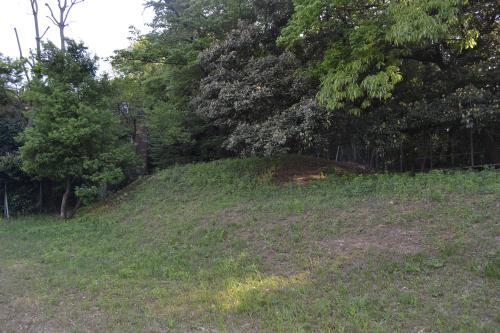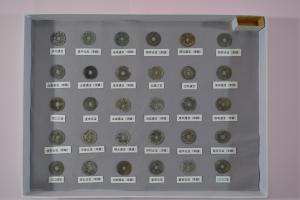Hirao Nyujōzuka Excavated Artifacts and Excavation Survey Materials

Hirao Nyujōzuka
Near the boundary between Hirao in Inagi City and Asao Ward in Kawasaki City, there is a mound called Nyujōzuka. Nyujō generally refers to entering meditation or the passing of a saint. Kūkai, the founder of Shingon Buddhism, taught that by entering meditation, one awaits the arrival of Maitreya Bodhisattva. Following this teaching, from the medieval period onwards, monks of Shingon Esoteric Buddhism performed Nyujō in various places. They chanted sutras while alive and underwent rigorous training to be buried inside the mound, waiting for the arrival of Maitreya Bodhisattva.
The burial mound located in Hirao was excavated in 1959. From the inscription on a stone tablet that was unearthed, it was revealed that a monk named Nagakushin entered meditation on August 15, 1536, in the 5th year of the Tenmon era. The mound is square, with each side measuring approximately 10.8 meters, and it contains a main chamber measuring about 1.8 meters by 2.1 meters. It is believed that pillars were erected at the four corners of this location to create a room enclosed by wooden boards, where the meditation practice took place. The top of this main chamber was covered with a layer of clay, and additional earth was piled on top to construct the mound.
A total of 103 items, including one ritual dagger believed to have been used for ceremonies, 44 copper coins that were brought from China, 7 iron nails thought to have been used to construct the main facility, and 51 materials from the excavation survey, have been designated as tangible cultural assets of Inagi City.
Hirao Nyujōzuka Excavated Items
The excavated artifacts from the designated burial mound include a total of 52 items: 44 copper coins, 7 iron nails, and 1 iron knife.
Copper coins were imported from China, including Tang coins, Song coins, and Ming coins, some of which are illegible. The most commonly found coins are Song coins (from the 10th to the 13th century). These copper coins are believed to have been used in the ritual of entering meditation. During the medieval period, the minting of currency within Japan was not active, and it was an era when imported coins from China were predominantly in circulation. It is thought that the imported coins that were commonly circulated at that time were used in the ritual of entering meditation.
Iron nails were found along with charred wood around the main body. They range in length from 8 centimeters to 13 centimeters and are quite deteriorated, but they are square in cross-section and are believed to have been used as nails for constructing the wooden enclosure of the main body. The iron knife measures 24.5 centimeters in length and 2 centimeters in maximum width, and it is thought to have been used for rituals conducted at the main body.
Excavation Survey Materials
This is the material created from the excavation survey conducted in August 1959. The materials include 2 rubbings of stone tablets, 14 detailed drawings of the site and structures, 33 survey photographs, and 2 draft manuscripts, totaling 51 items. The rubbings are from 2 of the 9 stone tablets unearthed from the main body. One of the rubbings features the inscription "In the fifth year of Tenmon, on the 15th day of the month of Hino, the monk Choshin entered Nirvana," making it a valuable resource that reveals the construction date of the Nirvana mound and the name of the monk who entered Nirvana. The detailed drawings include the overall measurement of the mound, floor plans of the structures, cross-sectional diagrams of the soil layers, and floor plans of unearthed artifacts (such as stone tablets) and iron nails. The survey photographs depict the overall view of the Nirvana mound, cross-sections of the soil layers, the condition of the unearthed stone tablets, the state of the clay layers, the condition of the unearthed coins, the overall view of the main body, and the condition of the floor surface of the main body. The draft manuscripts are believed to be rough drafts for the survey report, detailing the location, scale, facilities of the main body, and the condition of the unearthed stone tablets. In total, there are 15 sheets of 400 characters each. These excavation survey materials, along with the artifacts unearthed from the Nirvana mound, are considered indispensable and important resources for understanding the reality of the medieval Nirvana mounds and the circumstances of the excavation survey.

Please let us know your feedback on how to make our website better.
Inquiries about this page
Inagi City Local History Museum
1-9-1 Hirao, Inagi City, Tokyo 206-0823
Phone number: 042-331-0660 Fax number: 042-331-0660
Contact the Lifelong Learning Division, Department of Education, Inagi City



















